Motorcycle training - positioning and cornering tips
Positioning
Car drivers are relatively
limited
in their ability to alter their position within the lane, since they
normally
occupy about 50 - 70% of it. Hence, most car drivers focus on
keeping
their vehicle centrally within the lane. Motorcycles on the other
hand occupy a very small %age of the lane and can use this to great
advantage.
You can alter your road position to:
|
|
Improve your view of the
situation ahead |
|
|
Improve your chances of being
seen by
other road users |
|
|
Avoid hazards in the road or
improve surface
grip |
|
|
Reduce the severity of a corner
or bend |
|
|
Give information to influence
other road
users |
Improving your view
Most advanced riding
literature
states that you should always ride at a speed which will enable you to
stop in the distance you can see to be clear, on your own side of the
road.
Therefore, if we can only see a short distance, we must ride more
slowly.
Apart from weather conditions we find that obstructions stop us from
seeing
ahead. This may be another vehicle, a tree, a building etc., so
where
possible and where safe we need to position our bike to allow us to see
around the obstacle and thus allow us to extend the safe stopping
distance
and the time we have to react to a hazard.
The simple diagram bellow
shows
two typical blind right and left hand bends. Notice that despite
both bikes being at the same stage of the bend, only the blue bike can
see the potential oncoming hazard.
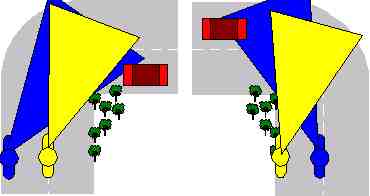
The same rules can be applied
when passing a row of parked cars (or any obstruction). By moving
out and away from the obstruction, you are improving your view and
reducing
the risk of being hit by someone opening a car door. You are also
improving your chances of seeing and reacting to stray pedestrians or
vehicles
coming out of driveways.
Improving
your chances of being seen
In addition to being able to
see
the potential hazard, there is also a good chance that the blue rider
can
be seen by the driver in the red car. It is important to remember
that as a motorcyclist you have a relatively small profile.
Statistics
show that 1 in 3 motorists don't notice motorcycles, so you should do
everything
you can to increase your road profile. Generally, you should ride
in a prominent position giving you a good view of the road ahead and
the
flexibility to react to the unexpected. Provided you are not on a
motorway, this is normally near the centre of the road. Be aware
that other vehicles may interpret this as an indication to turn, so
keep
a good look out for traffic coming up behind you. In this
position,
you are more likely to be seen by oncoming traffic and will also stay
out
of the blind spots of traffic ahead of you.
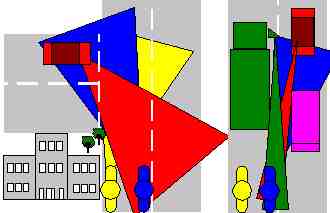 The diagram demonstrates just how
vulnerable
the yellow rider is compared with blue. Apart from not having a
clear
view of the road, they are also less likely to be spotted by other
vehicles.
In the second example the blue bike should be moving to the left
(slightly) to avoid coming into conflict with the oncoming vehicle
(this
is discussed in the next section).
The diagram demonstrates just how
vulnerable
the yellow rider is compared with blue. Apart from not having a
clear
view of the road, they are also less likely to be spotted by other
vehicles.
In the second example the blue bike should be moving to the left
(slightly) to avoid coming into conflict with the oncoming vehicle
(this
is discussed in the next section).
Avoiding
Hazards
Even the best of British roads
are not built with motorcycles in mind. You'll notice all sorts
of
hazards from uneven repairs, pot holes, paint and metal covers which as
a minimum will be uncomfortable to ride over, but more often will upset
the stability of your bike. In bad weather, you should also be
aware
of micro climates (e.g. patches of ice on an otherwise dry road often
caused
by shade) and standing water after rain. Wherever possible, you
should
avoid these hazards, by planning a route around them. All roads have some hazards to deal
with,
even if the road is empty and straight, the edge of the road presents a
hazard. This is another reason why positioning close to the
centre
of the road reduces your risk. You are roughly equal and
therefore
the maximum distance apart from the two hazards. If however you
spot
a vehicle coming the other way, or a traffic island, you should move
over
slightly (centre of your lane) to maintain that equal distance.
If
the hazards are not equal (e.g. a large truck coming the other way),
then
consider moving over more. When planning your positioning, you
should
consider the following in order:
 |
Safety
The ideal position for a
left
hand bend is over to the right (centre line), but you should give up
this
position if you see oncoming vehicles. (less view, but further
away
from the hazard). Safety is the highest priority
Stability
The ideal position for a
right
hand bend is over to the left, for maximum view around the bend, but
the
road on the edge is often full of debris and poor surfacing. This
will affect your stability, so you should compromise your positioning
(less
view but more stability). Stability should be considered above
maintaining
the best view of the road.
View
If it's safe and the
road surface
is good position for maximum view. Providing there is an
advantage
in doing so.
The diagram shows two riding
plans:
The solid line shows where the rider has compromised view for
safety.
In addition where the second bend is open it may be safe to improve
stability
by staying upright. This would not be acceptable if the rider
could
not be certain that there were no oncoming vehicles. The dotted
line
represents the uncompromised route that does not prioritise safety or
stability
over view. |
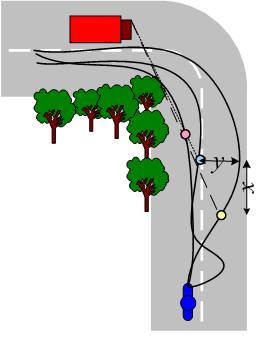 |
When choosing a position
it is important
not to increase the distance we can see, at the cost of needing more
time
to get back to our own side of the road. This is shown in the
diagram
(left) with three potential plans. The coloured dots show the
point
that the oncoming hazard would come in to view. The yellow point
has the earliest view (extra advantage shown as x), but has the
furthest to travel to return to the safe position (shown as y).
The pink route sees the hazard last, but has least adjustment to
make.
The blue route offers the best combination of the two and also shows a
brief excursion to the offside, early on where safe and can improve our
perception of the bend. This initial sideways movement helps us
gain
a second view point to get a better picture of how tight the bend
is.
It essentially widens our 3D view.
When considered using the
off-side it's
worth noting that:
-
Any oncoming drivers may panic
when they see
you on the wrong side of the road and react unpredictably.
-
Any gain in view may be lost by
the extra
effort required to return to safety, this may result in a lower
cornering
speed due to the need to be able to stop safely on our own side of the
road in the distance we can see to be clear.
-
It can appear dangerous or
confusing to other
motorists who may be following.
|
Reducing
the severity of a bend
Motor-sport has been doing
this
for years, to enable the maximum speed possible to be achieved while
going
round a bend, often referred to as taking the racing line.
However
as road riders, we should remember that a race car or bike doesn't
expect
to find traffic coming the other way and will normally not have to deal
with blind or unknown bends. It is important to note that taking
the race line around a bend will significantly reduce your visibility,
limit your options for reacting to hazards and reduce your ability to
plan
ahead. Safety and visibility must always take priority over
smoothing
a bend, but there is a point when it can be done. This is
normally
the point when the bend starts to straighten out. Obviously if
the
bend is minor and you can see it is safe to do so, then you can
consider
straight lining it.
Positioning
to influence
When considering adopting any
road position, it is important remember that other road users may
interpret
it wrongly. Tucking in to the left, on a right hander, may
indicate
to following traffic, that you are stopping or moving over to allow
them
to pass. Always be prepared to compromise your road position, if
you feel that it could give false information. You must always
prioritise
your hazards and ensure you deal with the most immediate first.
If
you have a car approaching from an entrance and a right hand bend soon
after, moving to the left to get a good view of the bend ahead, could
be
interpreted as an intention to turn left. Any car approaching could
pull
out in front of you. In this case you will need to sacrifice your
early view of the corner, in order to give information to the
approaching
vehicle.
Here are some other examples
of
when you may need to take an alternative position: Lane Sharing - Imagine you are
approaching
a ‘T’ junction on a busy intersection and intending to turn
right.
Your ‘L’ test text book will have told you to move over to the
right.
However, an impatient motorist behind you may feel there is sufficient
space to ‘lane share’. They may even spot a gap before you and
attempt
to beat you out of the junction. Your courteous action may
inadvertently
put you in danger. You risk being hit, when the other car comes
along
side, pulls away and you could get pushed out into the path of oncoming
traffic if you both exit at the same time. In such a case it may
have been better to take a more central position (within your
lane).
This will create less room for a vehicle to squeeze along side and may
discourage them from lane sharing. The same applies when waiting
at traffic lights. Multiple Lane Roundabouts - If you're going straight over on a roundabout, the highway code says
you
take the left lane and indicate just before you exit. However,
many
motorists will assume that your are turning left and may pull out in
front
of you or move into your path without realising that you didn't
exit.
Again you will need to use your judgement as to the best lane to
take.
It may be better to use the middle lane and watch out for motorists in
the correct lane. Corner Cutting - You're
turning
right from a minor road narrowed by parked cars , into a major
road.
If you take your normal right hand position, you run the risk of being
swiped by a car turning into your road and misjudging the gap. By
taking a central lane position, or hanging back from the junction
(assuming
you can still see), you reduce this risk. The busier the traffic, the
greater
the caution you will need to exercise. Not just because there are
more hazards to look out for, but also because other motorists will be
prepared to take greater risks in order to avoid the chaos. Road
positioning can help you make safer, smoother progress and give you an
early view of hazards, but never forget your immediate surroundings or
sacrifice your safety for a better position.
Cornering
 Cornering
can be the most challenging and enjoyable aspect of motorcycle
riding.
If done correctly you will feel confident, in control of your machine,
able to make good progress and get a clear view of the road
ahead.
If done badly you will have some of the scariest moments of your riding
career. Poor cornering ability is responsible for most bike
accidents
which do not involve other vehicles. Enter a corner too fast,
grab
the brakes mid corner when you realise you can't make it and you're
well
on your way to a visit to the ditch and possibly the local Accident
&
Emergency. Cornering
can be the most challenging and enjoyable aspect of motorcycle
riding.
If done correctly you will feel confident, in control of your machine,
able to make good progress and get a clear view of the road
ahead.
If done badly you will have some of the scariest moments of your riding
career. Poor cornering ability is responsible for most bike
accidents
which do not involve other vehicles. Enter a corner too fast,
grab
the brakes mid corner when you realise you can't make it and you're
well
on your way to a visit to the ditch and possibly the local Accident
&
Emergency.
 |
What makes a good corner?
Ideally you should be able to take the line you want, make smooth
progress
without braking and be able to react to any potential hazards. |
 |
What makes a bad corner?
Braking mid corner, running wide, deviating from your preferred line or
braking traction are all symptoms of poor cornering technique. |
Maintaining
Traction
Before going into the
techniques
you can use to improve your cornering ability, it is worth going over
the
basics of traction (grip). It is essential that you maintain grip
throughout your cornering manoeuvre as it highly likely that that a
skid
or slide will result in a spill. Any moving object carries momentum,
when
you change the direction of an object, it's momentum will want to carry
it in the direction it was travelling. On your motorcycle the
force
of the engine and the grip of your tyres is the only thing making you
turn.
Too much momentum against too little grip will result in a slide.
The following lists some factors which will affect your grip:
|
|
Surface conditions -
Rain, grease,
ice, paint, mud, oil etc., will all reduce tyre grip, as will a poor
road
surface or worn out tyres. |
|
|
Balance - Changing the
balance
of your bike during the corner will cause the force to shift on your
tyres.
Braking will cause the force to move towards the front, accelerating
will
move it to the rear. Too much of either will result in a slide. |
|
|
Angle - The camber
of the
road and the amount you lean the bike over will determine the area of
the
tyre you use and ultimately how much grip you will get. |
Your tyres are only capable of
providing a limited amount of grip, you have to decide how you
want
to use it. If you need too much for braking, you'll have less
available
for accelerating and cornering. If you are running out of cornering
grip, braking will increase your chances of loosing traction.
Also
too much braking will compress the forks and make it harder to steer.
Judging
the severity of the bend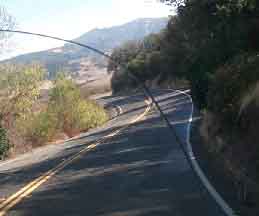 .The
severity of the bend will ultimately determine your approach speed, but
it is not always obvious from the entry point how severe the bend
is.
Here are some points which will help you decide; .The
severity of the bend will ultimately determine your approach speed, but
it is not always obvious from the entry point how severe the bend
is.
Here are some points which will help you decide;
: Road
Signs - Most roads will have some sort of warning sign indicating
the
severity of the bend look for this and any warnings painted on the
road.
These will give the most obvious indication of the severity of the bend. Road
Signs - Most roads will have some sort of warning sign indicating
the
severity of the bend look for this and any warnings painted on the
road.
These will give the most obvious indication of the severity of the bend.
 Vanishing
Point - As you approach the bend find the point where, according to
your eye, the two sides of the road join ‘the vanishing point’ if
this seems to be getting closer to you, the bend is tightening up, if
it
is moving away from you, the bend is opening out. Vanishing
Point - As you approach the bend find the point where, according to
your eye, the two sides of the road join ‘the vanishing point’ if
this seems to be getting closer to you, the bend is tightening up, if
it
is moving away from you, the bend is opening out.
 Other
Vehicles - Are vehicles ahead of you braking hard as they enter the
corner? Are vehicles coming the other way moving slowly? If the
answer
is yes, the corner may be more severe than you think.You should also understand the vertical
factors such as cambers and hills which affect a bend. A banked
bend
and an incline has the effect of reducing the severity, while adverse
camber
or decline increases it.The
basic
approach Other
Vehicles - Are vehicles ahead of you braking hard as they enter the
corner? Are vehicles coming the other way moving slowly? If the
answer
is yes, the corner may be more severe than you think.You should also understand the vertical
factors such as cambers and hills which affect a bend. A banked
bend
and an incline has the effect of reducing the severity, while adverse
camber
or decline increases it.The
basic
approach
Throughout the cornering
manoeuvre
you should constantly seek information about the changing situation
which
may require you to react. At each stage think about the potential
hazards that can occur and how you might manage them. Constantly
ask yourself ‘can I stop safely if I need to?’ - Always expect an
oncoming
car with two wheels in your lane, just around the bend.
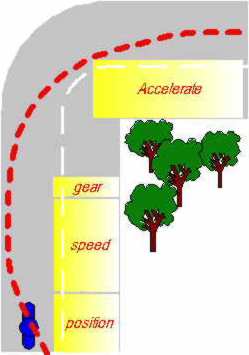
|
-
Position - As you approach
the corner adopt the most appropriate position for the bend. When
choosing your position, consider in order your safety, stability and
information
(view) needs, when determining the best position.
Resist the temptation to smooth the bend too early as this will impact
your view and limit your options.
-
Speed - Aim to settle
your entry speed in good time, remember slow in = fast out. This
will allow you to gather information as you prepare to round the bend
and
keep the power on around the bend, which will improve your
stability.
Use the vanishing point to check that your speed remains appropriate,
if
it moves within your safe stopping distance, you'll need to slow down,
if it moves away you may speed up.
-
Gear - Selecting the
appropriate gear will have a huge impact on your control as you take
the
bend. Choose an appropriate gear that will allow you to
adapt.
If the bend tightens, you'll need to slow down. If you have
selected
a low gear you'll be able to engine brake to wash off speed. This
will affect the stability of your bike much less than applying the
brakes
-
Accelerate - As you reach
the end of the corner (vanishing point moves away) and providing it is
safe, smoothly roll the power back on as you bring your bike upright
continue
to accelerate until you reach the desired speed or other conditions
apply.
As soon as the bend hazards have past, start searching for the next
hazard,
resist the temptation to power out of the bend, as there may be a speed
limit change or another bend ahead.
Key Tips:
-
Keep the
power on slightly
as you round the bend, to counter the effect of the turn and
maintain
your bike's stability. This also encourages the rear wheel to track
outwards,
which will increase the tightness of the turn, requiring you to lean
the
bike over less. Closing the throttle will reduce this and
encourage
the bike to stand up and run wide.
-
Keep your
head up and physically
look where you want to go, this will help you put the bike where
you
want it to be and the position will feel more natural. If you
stare
at the edge of the road, it's where you'll end up.
-
Avoid using
the brakes when
cornering If you need to slow down use engine braking, if that is
not
enough use only the rear brake with extreme caution. In 9 out of
10 situations applying the brakes will not improve things and is likely
to make the steering heavier and encourage the bike to sit up and run
wide.
The only time braking will help, is if the bend goes down hill.
Physically
leaning your body toward the turn will tighten your line and reduce
your
lean angle.
-
Keep your
arms loose and
your weight off the bars, as this will increase your control.
If you press down slightly on the pegs you'll find the steering becomes
a lot lighter and the bike will be more responsive.
- Use Counter Steering
to initiate the turn - Counter Steering is steering the bike in
the opposite direction.
|
|
